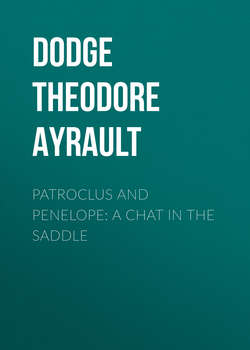Читать книгу Patroclus and Penelope: A Chat in the Saddle - Dodge Theodore Ayrault - Страница 11
X
ОглавлениеThe manège need not mean all the little refinements of training which, however delightful to the initiated, are unnecessary to comfort or safety. But no horse can be called a good saddle beast whose forehand and croup will not yield at once to the lightest pressure of rein or leg. Most horses will swing their forehands with some readiness, if not in a well-balanced manner. But not many are taught to swing the croup at all; very few can do so handily. The perfect saddle horse should be able to swing his croup about in a complete circle, of which one fore foot is the immovable centre, or his forehand about the proper hind foot, in either direction at will. He should come "in hand," that is, gather his legs well under him, so as to be on a perfect balance the moment you take up the reins and close your legs upon him. He should in the canter or gallop start with either foot leading, or instantly change foot in motion at the will of his rider. He should have easy, handy gaits, the more the better, if he can keep them distinct and true. These accomplishments, added to a light mouth and a temper of equal courage and moderation, or, in short, "manners," make that rare creature, – the perfect saddle horse.
It is in this that the English err. In their perfect development of the hunter and the racer they neglect the training of the hack. Though it be heresy to the mania of the day to say so, it is none the less true that while you seek your bold as well as discreet and experienced cross-country rider in England, you must go to the Continent, or among the British cavalry, to find your accomplished horseman.
It is the general impression among men who ride to hounds, and still more among men who pretend to do so, that leaping is the ultima thule of equestrianism; and that a man who can sit a horse over a four-foot hurdle has graduated in the art of horsemanship. The corollary to this error is also an article of faith among men who hunt, that is, that no other class of riders can leap their horses boldly and well. But both ideas are as strange as they are mistaken.
The cavalry of Prussia, Austria, and Italy show the finest of horsemanship. More than a quarter century ago, the author spent three years in Berlin under the tuition of a retired major-general of the Prussian army, and saw a great deal of the daily inside life, as well as the exceptional parade life, of the army. He has often seen a column of cavalry, with sabres drawn, ride across water which would bring half the Myopia Hunt to a stand-still on an ordinary run after hounds. Why should not men whose business it is to ride, do so well?
Think you there was not good horsemanship at Vionville, when von Bredow (one of the author's old school friends, by the way) with his six squadrons, to enable Bruddenbrock to hold his position till the reinforcements of the Tenth Corps could reach him, rode into the centre of the Sixth French Corps d'Armée? In slender line, he and his men, three squadrons of the Seventh Cuirassiers, and three of the Sixteenth Uhlans, charged over the French artillery in the first line, the French infantry in line of battle, and reached the mitrailleuses and reserves in the rear, where they sabred the gunners at their guns. What though but thirteen officers and one hundred and fifty men out of near a thousand returned from that gallant ride? Though no Tennyson has sung their glorious deed, though we forget the willing courage with which they faced a certain sacrifice for the sake of duty to the Fatherland, think you those men rode not well, as a mere act of horsemanship?
Think you that the handful of men of the Eighth Pennsylvania, at Chancellorsville, when they charged down upon Stonewall Jackson's victorious and elated legions, riding in column through the chapparal and over the fallen timber of the Wilderness, carving their path through thousands of the best troops who ever followed gallant leader, sat not firmly in their saddles? Think you that the men who followed Sheridan in many a gallant charge, or Fitz Hugh Lee, forsooth, could not ride as well as the best of us across a bit of turf, with a modest wall now and then to lend its zest to the pleasure? Neither we nor our British cousins can monopolize all the virtue of the world, even in the art equestrian.
As there is no doubt that fox-hunting is one of the most inspiriting and manly of occupations, or that the English are preëminent in their knowledge of the art, so there is likewise no doubt that equally stout riders sit in foreign saddles. And though each would have to learn the other's trade, I fancy you could sooner teach a score or a hundred average cavalry officers of any nation to ride well across country, than an equal number of clever, fox-hunting Englishmen to do the mere saddle work of any well-drilled troops. Leaping is uniformly practiced and well-taught, in all regular cavalry regiments of every army with which I have been familiar in all parts of the world.
